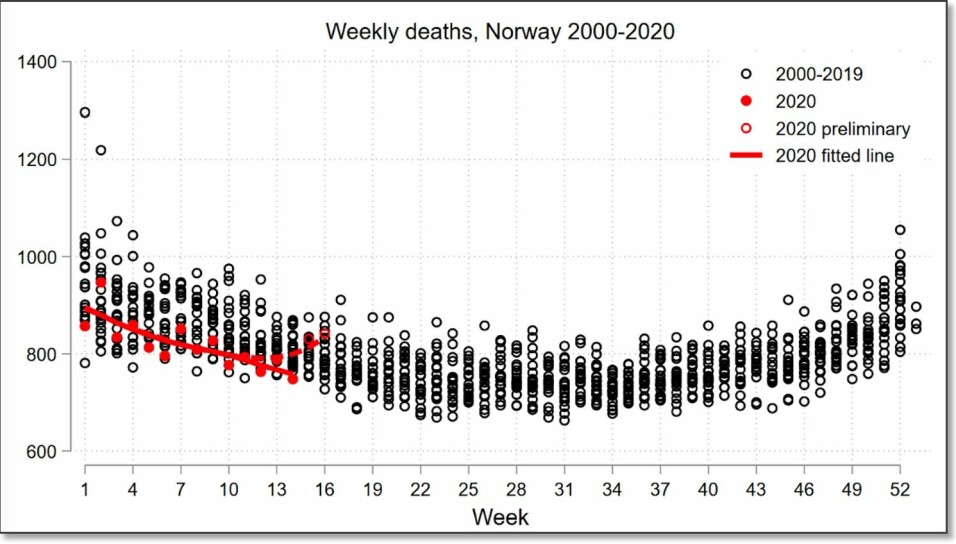
The coronavirus pandemic is now the most-covered topic by the Norwegian media — ever
Over the past 70 years, cancer has been the disease that has been most widely covered by Norwegian media, with some exceptions. But then came the coronavirus.
The coronavirus crisis is now the most covered event in Norwegian media of all time.
No other event has received such broad coverage, based on the number of media reports, over such a short time, according to the media monitoring and analysis agency Retriever.
Until now, Norwegian media coverage of the July 22, 2011 terrorist attack has topped these statistics.
Cancer is in a league of its own
However, when the world was “normal”, cancer was in its own league with respect to media coverage of diseases, according to Elisabeth Jakobsen, who is a communications manager for the Cancer Registry of Norway.
She was curious about how the press covers health issues and took to Retriever's database of articles on the web, paper, television and radio. She also looked at the National Library's collection of Norwegian paper newspapers from the 1950s to the present.
Coverage of the different cancer diseases has increased since the 1950s, but especially after 2000, Jakobsen found.
Four exceptions

But there are some exceptions.
“From the 1950s until now, there are only a few isolated situations where other diseases and health-related issues have been given the same amount of attention as cancer,” Jakobsen says.
Since 1950, she found only four examples that pushed cancer out of the media limelight.
“With one exception, these situations all share frightening and dramatic threats to life and health. They are about infection, viruses and epidemics that threaten to get out of control,” she says.
Tuberculosis in the 1950s
At the beginning of the 1950s, the big issue was tuberculosis.
During this decade, Norway was able to more or less fight back this disease, which had taken so many lives. The media consequently became less interested in writing about it.
By the end of the 1950s, cancer was mentioned more than twelve times as often as tuberculosis, Jakobsen says.
In today's Norway, tuberculosis has pretty much disappeared from the public eye, but the disease still rages in large parts of the world.

AIDS in the 1980s
In the mid-1980s, the whole world became preoccupied with the AIDS epidemic. The media was no exception. By the end of the decade the epidemic peaked.
Being infected by the HIV virus no longer means a death sentence, due to good treatment options. But men, and to some extent also, women, are still infected by this dreaded virus.
In parallel to the AIDS epidemic, the media began to cover illnesses in a new way, Jakobsen says.
“A focus on the patient, which is now central to press coverage of all health issues, appeared to be accelerating with the AIDS epidemic. The ribbon concept spread, and we wore red ribbons in solidarity with AIDS victims,” she says.
In subsequent years, the cancer field has also embraced the solidarity ribbons, especially breast cancer with its pink ribbon.

Swine flu in 2011
The last major pandemic also got far more media coverage than cancer, Jakobsen says. But most of the news coverage was in 2011, and later the disease quickly disappeared from the news picture.
Harald Hornmoen, a media professor at Oslo Metropolitan University (OsloMet) studied the media's treatment of the swine flu. He concluded that coverage in the main Norwegian newspapers was one-dimensional at critical stages. There was little room for criticism.
"Rather, government information was adapted and reinforced in a distinct crisis discourse with an associated fear rhetoric. A key function was to scare people into acting adequately in relation to the threat," he wrote in a 2011 article in Tidsskrift for samfunnsforskning (Journal of Social Research).
Abortion in the 1970s
In the 1970s, Jakobsen found a health-related topic that went far beyond cancer in terms of the amount of media coverage.
This was not an illness-related issue, and was perhaps as much about politics and equality as health.
“Abortion has received more attention than cancer over the long term— for a total of five years in the mid-1970s. At that time, there were more mentions of abortion in the media than cancer,” she says.
Breast cancer gets the most coverage
There are significant differences in how the media covers different types of cancer.
Breast cancer has received the most media coverage for a number of years. Breast cancer has received a total of 17,000 more media articles than lung cancer, which is the second most frequently covered cancer, Jakobsen found.
Among the major cancers, bladder cancer and rectal cancer receive the least media attention.

Is cancer forgotten?
At the end of the 2010s, there was an increase in attention from the press about mental health.
By the end of 2019, coverage of mental health issues appeared to be about to overtake cancer coverage, the Cancer Registry of Norway writes on its website.
But that was before the coronavirus came and turned everything on its head, both in the media and in society at large.
Translated by: Nancy Bazilchuk
Source:
Cancer in the press, theme article at the Cancer Registry, April 2020
———

































